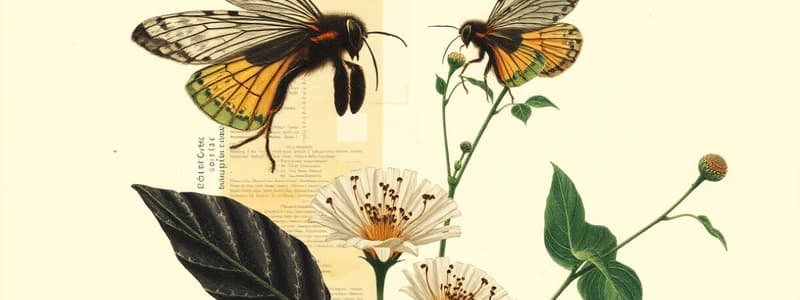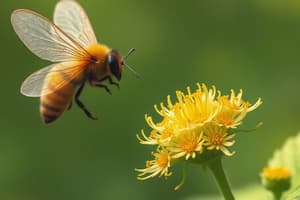Podcast
Questions and Answers
Which of the following describes the role of nectar in plant biology?
Which of the following describes the role of nectar in plant biology?
- A nutrient storage compound within root systems.
- A structural component of plant cell walls.
- An attractant for pollinators to facilitate pollen transfer. (correct)
- A defense mechanism against herbivores.
How does double fertilization, a unique characteristic of angiosperms, contribute to plant development?
How does double fertilization, a unique characteristic of angiosperms, contribute to plant development?
- It creates both the embryo and the endosperm to nourish the developing embryo.
- It leads to the formation of a protective layer around the seed.
- It prevents cross-pollination by ensuring self-fertilization. (correct)
- It results in the production of two identical offspring.
What primary role do secondary compounds play in plant survival?
What primary role do secondary compounds play in plant survival?
- Defending against herbivores and pathogens.
- Providing structural support to stems and leaves.
- Attracting specific pollinators through scent.
- Enhancing the rate of photosynthesis. (correct)
In angiosperms, what is the function of the endosperm?
In angiosperms, what is the function of the endosperm?
Which of the following accurately describes how eudicots and monocots differ in leaf vein structure?
Which of the following accurately describes how eudicots and monocots differ in leaf vein structure?
How does the timing of anther maturation relative to stigma receptivity affect cross-pollination in angiosperms?
How does the timing of anther maturation relative to stigma receptivity affect cross-pollination in angiosperms?
Why do water lilies have stomata on the upper surface of their leaves?
Why do water lilies have stomata on the upper surface of their leaves?
What evolutionary advantage do insectivorous plants gain from trapping insects?
What evolutionary advantage do insectivorous plants gain from trapping insects?
Which statement best describes the evolutionary trend from gymnosperms to angiosperms?
Which statement best describes the evolutionary trend from gymnosperms to angiosperms?
What is the role of amylase enzymes in the context of parenchyma tissue and the edible parts of an apple?
What is the role of amylase enzymes in the context of parenchyma tissue and the edible parts of an apple?
How does the presence or absence of secondary walls relate to the function of parenchyma cells?
How does the presence or absence of secondary walls relate to the function of parenchyma cells?
What structural feature differentiates collenchyma cells from parenchyma cells, and how does this difference relate to their respective functions?
What structural feature differentiates collenchyma cells from parenchyma cells, and how does this difference relate to their respective functions?
What characteristics make sclerenchyma cells well-suited for providing structural support?
What characteristics make sclerenchyma cells well-suited for providing structural support?
How do adventitious roots differ from taproots in terms of origin and structure?
How do adventitious roots differ from taproots in terms of origin and structure?
Which of the following best describes the function of pneumatophores?
Which of the following best describes the function of pneumatophores?
What role does the apical bud play in a plant's growth pattern, and how is this influenced by apical dominance?
What role does the apical bud play in a plant's growth pattern, and how is this influenced by apical dominance?
Which of the following best describes the organization of a stem?
Which of the following best describes the organization of a stem?
How is the photosynthetic function distributed in cacti, considering their modified leaves (spines)?
How is the photosynthetic function distributed in cacti, considering their modified leaves (spines)?
How do tubers, such as potatoes, function as modified stems?
How do tubers, such as potatoes, function as modified stems?
Which characteristic is often observed in plants growing in nitrogen-poor soils as an adaptation for survival?
Which characteristic is often observed in plants growing in nitrogen-poor soils as an adaptation for survival?
Flashcards
Plant Defenses
Plant Defenses
Plant's defenses against herbivores and pathogens, including physical barriers, chemical compounds, and symbiotic relationships.
Nectar
Nectar
Sugary fluid produced in flowers to attract pollinators, providing them with energy in exchange for pollen dispersal.
Pollination
Pollination
Transfer of pollen from the male part (anther) to the female part (stigma) of a flower, leading to fertilization.
Double Fertilization
Double Fertilization
Signup and view all the flashcards
Endosperm
Endosperm
Signup and view all the flashcards
Xylem
Xylem
Signup and view all the flashcards
Phloem
Phloem
Signup and view all the flashcards
Sperm's Role in Fertilization
Sperm's Role in Fertilization
Signup and view all the flashcards
Floral Leaves
Floral Leaves
Signup and view all the flashcards
Adventitious Roots
Adventitious Roots
Signup and view all the flashcards
Taproot System
Taproot System
Signup and view all the flashcards
Fibrous Root
Fibrous Root
Signup and view all the flashcards
Modified Roots
Modified Roots
Signup and view all the flashcards
Spines
Spines
Signup and view all the flashcards
Leaf
Leaf
Signup and view all the flashcards
Stems
Stems
Signup and view all the flashcards
Dermal Tissue
Dermal Tissue
Signup and view all the flashcards
Vascular Tissue
Vascular Tissue
Signup and view all the flashcards
Collenchyma
Collenchyma
Signup and view all the flashcards
Sclerenchyma
Sclerenchyma
Signup and view all the flashcards
Study Notes
- Secondary compounds help plants defend themselves.
- Plants space themselves out and attract pollinators.
Plant Defenses
- Plants have various defenses, including nectar, phenolic secretions, poison oak, and poison ivy.
- Some plants utilize ants and other insects for protection.
- Layers of bark that shred, sticky traps, and oils/saps deter critters.
- Plants with hallucinogenic or bad-smelling properties discourage animals.
- Chemical compounds and alkaline types of chemicals act as plant defenses.
Pollination
- Pollinators are attracted to flowers through nectar and other means.
- Some pollinators are drawn to scents resembling rotting corpses or feces.
- Pollen is transferred from one plant to another via pollinators.
Angiosperm Life Cycle
- Angiosperm life cycle includes both male and female parts in the flower.
- Mechanisms exist to prevent cross-pollination.
- Plants have multiple chromosomes, allowing adaptation to different morphologies.
- The flower contains male (anthers) and female (ovules) parts.
- Ovules contain megaspores and food.
- Pollen grain attaches to the stigma and divides into two sperm.
- Double fertilization: two sperm fertilize the egg and initiate endosperm development.
- Endosperm nourishes the developing baby plant.
Double Fertilization
- Double fertilization occurs when two sperm are discharged into the ovule.
- One sperm fertilizes the egg to form the baby plant (zygote).
- The other sperm combines with two nuclei to create the endosperm (food for the baby).
- The process is unique to angiosperms.
- This results in a triploid (3n) endosperm.
Angiosperms
- Double fertilization in angiosperms leads to the formation of the baby and its food source.
- Ovary around the seed attracts something to eat it.
Evolution
- The oldest known angiosperm fossil is 162 million years old from the mid-Jurassic period in China.
- Basic primitive fossils of angiosperms are often found near water.
- Male and female parts (stamens and carpals) are modified leaf structures.
Eudicots and Monocots
- Angiosperms are divided into two main groups: dicots and eudicots.
- Eudicots called "true dicots."
- Cotyledons are the first leaves of a plant.
- Dicots have two cotyledons, while monocots have one.
- Two thirds of angiosperm species aee eudicots
Plant Structures
- Magnoliids are very ancient flowering plants.
- Flowers may appear before leaves in some plants like magnolias.
- Grasses and other monocots have tiny flowers.
Plant Anatomy and Tissues
- Plants have organs composed of tissues, which are composed of cells.
- Roots rely on sugars produced by photosynthesis, while shoots rely on water and minerals from the roots.
- Roots anchor the plant, absorb minerals and water, and store organic nutrients.
- Tap root systems have a main vertical root with lateral roots (e.g., California Poppy).
- Adventitious roots arise from stems or leaves.
- Roots and fungi work together almost immediately to absorb food.
- Roots, stems, and leaves are the major plant organs
Modified Roots
- Modified roots include prop roots, aerial roots, food storage roots, and parasitic roots.
- Pneumatophores are aerial roots that help cypress trees avoid waterlogging.
- Parasitic roots (haustoria) penetrate other plants to obtain nutrients.
Stems
- A stem contains alternating nodes (where leaves attach) and internodes (between nodes).
- Roots developed coming from stems attached to the ground
- Modified stems include bulbs, corns, rhizomes, runners, tubers, tendrils, and cladophylls e.g. potatoes
- Runners grow above ground, while rhizomes grow underground.
- Tubers are underground modified stems for storage (e.g., potatoes).
- Cactuses use thorns for protection.
- Bulbous structures in plants like onions store energy
Auxiliary Definitions
- Auxiliary buds are structures with the potential to form new lateral shoots or branches.
- Apical buds are located at the tip of shoots and cause elongation.
- Apical dominance inhibits the growth of non-apical buds
- Cutting off the apical bud causes lateral buds to grow sideways.
Leaves
- The leaf is the main photosynthetic organ of a plant
- It consists of a flattened blade and a petiole (stalk).
- Leaf structure differs between monocots and dicots and arrangement of their veins.
- Monocots have parallel veins, while dicots have netted veins.
- Modified leaves include floral leaves, bracts, spines, reproductive leaves, and window leaves.
- Succulent leaves and cone-shaped leaves can allow photosynthesis.
Modified Leaves
- Plants can have modified leaves incl; tendrils, Succulent, insecticide leaves.
- Spines are modified leaves that provide protection.
- Some plants have succulents in their leaves to minimize the evaporation rate
- Plant can have window leaves that allow light in, and not let water out
- Insectivorous leaves trap insects to supplement nutrients (e.g., Venus flytraps)
- Pitcher plants are insectivorous leaves that trap insects.
- Plant can be carnivorous because Nitrogen is lacking in the soils
Plant Tissues
- Each plant organ has dermal, vascular, and ground tissue systems
- The dermal tissue consists of epidermis, and has is color coded
- Epidermis can have a waxy coating (cuticle) to prevent water loss and protect the plant (especially in drier climates)
- Ground tissue: It is essential
- Epidermis can be replaced by periderm in older plants.
- Vascular tissue is the plumbing in the plant.
- There different types of plant cells: Parenchyma, Collenchyma and Sclerenchyma.
- Vascular tissue is for water
Parenchyma Cells.
- Mature parenchyma cells have thin and flexible primary walls.
- Parenchyma tissue are fleshy parts of an apple has this tissues
- It does lack the secondary walls
Collenchyma Cells
- Collenchyma cells has thicker than the one just described(Parenchyma tissues)
- It gives the plants a little more sturdyness, and not as flimsy,
- Celery are primary example, they don't have the secondary walls
Sclerenchyma Cells
- There are rigid because of the thicker secondary cell walls, because it's strengthened with lignin, a material from wood and maturity
- At their functional maturity, the sclerenchyma cells are DEAD.
- Hemp and flax are an example,
Plant Xylem and Phloem
- The plumbing of the water in the parts, and the pholem
Studying That Suits You
Use AI to generate personalized quizzes and flashcards to suit your learning preferences.
Related Documents
Description
Explore plant defenses such as nectar, secretions, and symbiotic relationships with insects. Learn about pollination, including how plants attract pollinators through scents and nectar. Understand the angiosperm life cycle, covering male and female parts, and mechanisms to prevent cross-pollination.




